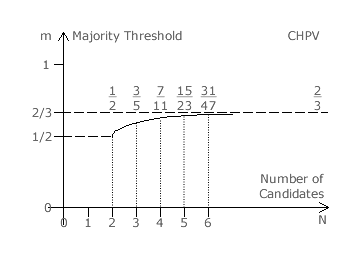Evaluations: Majority and Related Criteria 2
Two-Thirds Majority Criterion
If CHPV is employed in an election, what proportion of first preferences must a candidate receive in order to be guaranteed victory? This proportion (m) is specified on the previous page as m ≥ 1/(2-r) where r = 1/2 for CHPV. Hence, m ≥ 2/3 for CHPV as shown in the graph on that same page. Using CHPV, any candidate acquiring more than the majority threshold of two thirds of first preferences is guaranteed to win.
CHPV therefore satisfies the two-thirds majority criterion.
CHPV meets this criterion irrespective of the number of candidates standing in the election. When only a few candidates enter the contest and voters do not truncate their ballots, this majority threshold is somewhat reduced. The required majority of first preferences (m) varies with the number of candidates (N) and the common ratio (r) used; as given below.

For CHPV (where r = 1/2), the resultant relationship between m and N is shown in the graph opposite. For just two candidates a simple majority (m ≥ 1/2) is all that is required. With three candidates fighting the election instead, a 60% majority threshold (m ≥ 3/5) is needed.
As the number of candidates increases further, the majority threshold gets rapidly ever closer to the overall two-out-of-three (m ≥ 2/3) first preference requirement. Mathematicians call this rise an asymptotic approach.
Using CHPV in a single-winner election ensures that the candidate with the most first preferences is guaranteed to be elected if they have over two thirds of them. That is double the number any other candidate could achieve.
The leading first preference candidate is still likely to win even with less than two-thirds support unless the main challenger has broad support from voters in terms of high-ranking preferences and, apart from first preferences, the leading candidate does not.
Hence with CHPV, a powerful challenger could beat the otherwise leading candidate but only when that candidate has less than two thirds of first preferences and few other significant preferences. The figure of two thirds is an arbitrary yet popular, convenient and satisfying fraction for a majority threshold higher than one half. This very level of support is the minimal requirement for the election of a Pope.
Proceed to next page > Evaluations: Majority Criteria 3
Return to previous page > Evaluations: Majority Criteria 1
